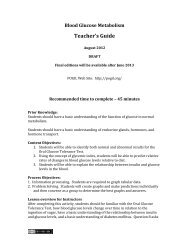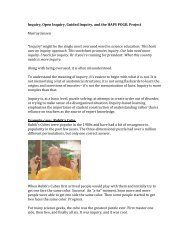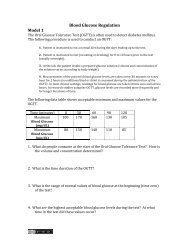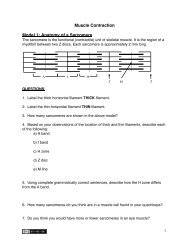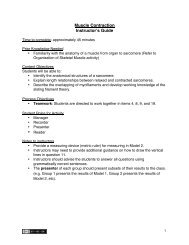Blood Glucose Metabolism Model #1:The Oral Glucose Tolerance ...
Blood Glucose Metabolism Model #1:The Oral Glucose Tolerance ...
Blood Glucose Metabolism Model #1:The Oral Glucose Tolerance ...
Create successful ePaper yourself
Turn your PDF publications into a flip-book with our unique Google optimized e-Paper software.
<strong>Model</strong> #2: <strong>Blood</strong> <strong>Glucose</strong> and <strong>Blood</strong> Insulin Levels<br />
Insulin is a protein hormone that is secreted into the blood by the pancreas.<br />
Clinicians rarely measure insulin levels, but the procedure is regularly done in<br />
research labs studying diabetes.<br />
<strong>The</strong> following data show blood insulin levels that correspond to the blood glucose<br />
levels in the OGTT used in <strong>Model</strong> 1.<br />
Measurements recorded during OGTT<br />
Time (minutes) 0 30 60 90 120<br />
Maria<br />
<strong>Blood</strong> <strong>Glucose</strong> (mg/dL)<br />
Maria<br />
<strong>Blood</strong> Insulin (pmol / L)<br />
Laura<br />
<strong>Blood</strong> <strong>Glucose</strong> (mg/dL)<br />
Laura<br />
<strong>Blood</strong> Insulin (pmol / L)<br />
90 140 150 135 110<br />
45 140 200 220 150<br />
110 170 220 270 300<br />
25 60 80 85 90<br />
QUESTIONS:<br />
7. What units are used to measure blood glucose? What units are used to<br />
measure blood insulin?<br />
8. On your own, draw two graphs-- one showing Maria’s glucose and insulin<br />
levels vs. time, and the second showing Laura’s glucose and insulin levels vs.<br />
time. After all individuals have completed drawing graphs, compare them with<br />
your group members. (Use a separate piece of paper if you choose)<br />
3




